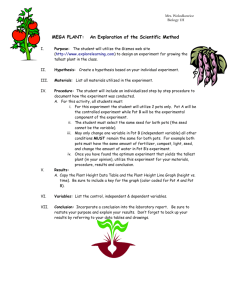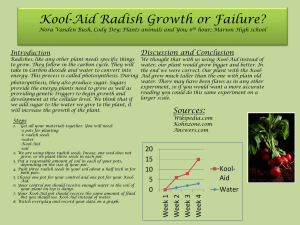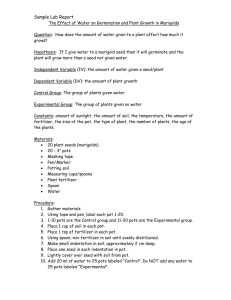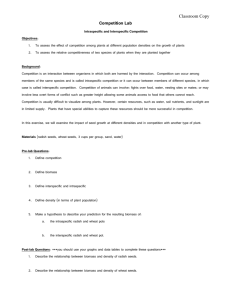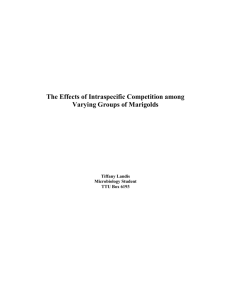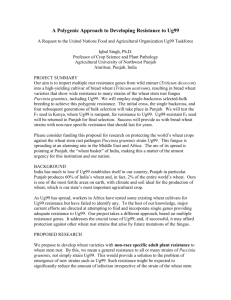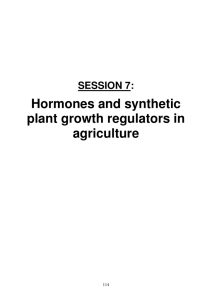Types of Competition
advertisement
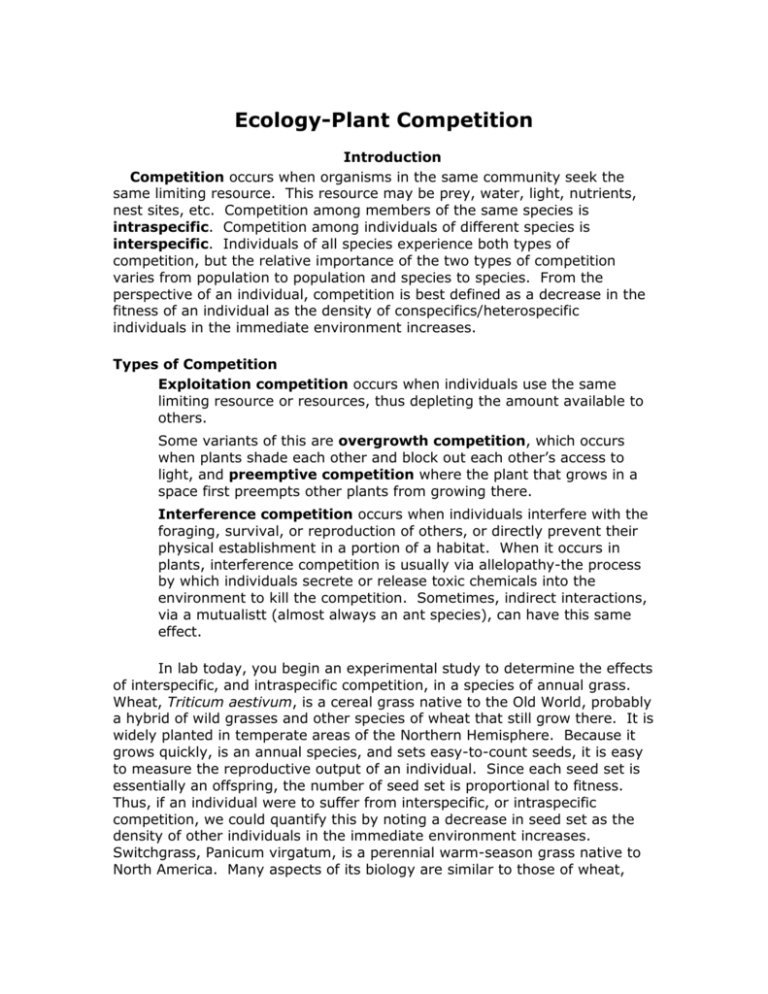
Ecology-Plant Competition Introduction Competition occurs when organisms in the same community seek the same limiting resource. This resource may be prey, water, light, nutrients, nest sites, etc. Competition among members of the same species is intraspecific. Competition among individuals of different species is interspecific. Individuals of all species experience both types of competition, but the relative importance of the two types of competition varies from population to population and species to species. From the perspective of an individual, competition is best defined as a decrease in the fitness of an individual as the density of conspecifics/heterospecific individuals in the immediate environment increases. Types of Competition Exploitation competition occurs when individuals use the same limiting resource or resources, thus depleting the amount available to others. Some variants of this are overgrowth competition, which occurs when plants shade each other and block out each other’s access to light, and preemptive competition where the plant that grows in a space first preempts other plants from growing there. Interference competition occurs when individuals interfere with the foraging, survival, or reproduction of others, or directly prevent their physical establishment in a portion of a habitat. When it occurs in plants, interference competition is usually via allelopathy-the process by which individuals secrete or release toxic chemicals into the environment to kill the competition. Sometimes, indirect interactions, via a mutualistt (almost always an ant species), can have this same effect. In lab today, you begin an experimental study to determine the effects of interspecific, and intraspecific competition, in a species of annual grass. Wheat, Triticum aestivum, is a cereal grass native to the Old World, probably a hybrid of wild grasses and other species of wheat that still grow there. It is widely planted in temperate areas of the Northern Hemisphere. Because it grows quickly, is an annual species, and sets easy-to-count seeds, it is easy to measure the reproductive output of an individual. Since each seed set is essentially an offspring, the number of seed set is proportional to fitness. Thus, if an individual were to suffer from interspecific, or intraspecific competition, we could quantify this by noting a decrease in seed set as the density of other individuals in the immediate environment increases. Switchgrass, Panicum virgatum, is a perennial warm-season grass native to North America. Many aspects of its biology are similar to those of wheat, though it is a perennial grass, and has a different type of photosynthesis (C4 rather than C3, which is present in wheat.) Pre-Lab Discussion 1) Before coming to class, look up at least one study of competition in plants, and be prepared to discuss it. Write a five sentence summary of what you learned and turn it in to your TA at the beginning of discussion. QUESTIONS FOR GROUP DISCUSSION A ) What were the goals of the competition study you researched? What was its outcome? Laboratory Exercise Directions: Your lab instructor has provided you with the following: 1) Plastic 2” by 2” pots. 2) Switchgrass seeds 3) Wheat seeds 4) Potting mix 5) Plant labels. This experiment will have three treatments, ALONE, INTERSPECIFIC COMPETITION, INTRASPECIFIC COMPETITION. Each table in your lab section will set up, and count, one replicate for each of the following. 1) Wheat alone. 2) Wheat at 5 individuals per pot 3) Wheat, alone, but with 4 switchgrass per pot. 1) Obtain three pots, the appropriate number of seeds (4 switchgrass, 7 wheat), a sharpie, and 5 plant tags. Fill your pots with mix. Label your tags 1 through 3. 2) For all your pots, plant a wheat seed directly in the center, about a half inch deep. 3) For treatment 1, use the tag you labeled 1 and leave it alone, it is, essentially, a control for both interspecific and intraspecific competition treatments. 4) For treatment 2, add 4 more wheat seeds, at the corners of the pot. 5) Likewise, for treatment 3, apply four switchgrass seeds, at four corners of the pot, respectively. 6) Place your pots in the planting tray when you are done. You will not be counting the particular pots you set up at the end of the experiment, nor will you be responsible for watering them. They will be watered by the UIC greenhouse staff, ad libitum, under ambient light. They will not be fertilized, though there is a small amount of fertilizer in the potting mix. Comparing Germination and Growth At about week 4 or 5, your lab group will compare growth rates of your wheat seedlings, as a sort of stand-in for fitness. Growth rates are more or less proportional to seed set for this species, because wheat is an annual species that has not evolved to set aside resources for future years. Seedlings have been selected to grow as quickly as possible, over the years, via artificial selection, so a decrease in growth rate can reasonably be expected to reflect the possible effects of competition. 1) You and the other members of your lab group should locate five pots, one from each treatment, and a ruler. For each pot. Measure the plant in the center, the FOCAL PLANT (because we will be measuring the effects of competition on this one individual, and not its effects on the other individuals), from the base of the soil to the tip of the longest leaf. Report your results to your laboratory instructor. You can analyze the class data using an ANALYSIS OF VARIANCE. The theory behind this test is a little bit beyond the scope of the class, but it is, in essence, a way of seeing if the treatment in which a seedling found itself affected its growth. Was there a significant effect of the treatment on the growth of your focal seedlings? Interpret the results. Comparing Seed Set The procedure for this part of the experiment is similar to the procedure described above, but in this case, count seeds from the focal individual. Was there a significant effect of the treatment on the number of seeds set by your focal seedlings? Interpret the results.
